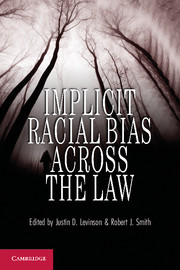Book contents
- Frontmatter
- Contents
- Contributors
- Acknowledgments
- Implicit Racial Bias Across the Law
- Introduction Racial Disparities, Social Science, and the Legal System
- 1 Implicit Racial Bias
- 2 Property Law
- 3 Criminal Law
- 4 Torts
- 5 Employment Law
- 6 Health Law
- 7 Education Law
- 8 Communications Law
- 9 Corporations Law
- 10 Tax Law
- 11 Intellectual Property
- 12 Environmental Law
- 13 Federal Indian Law
- 14 Capital Punishment
- 15 Reparations Law
- Index
- References
2 - Property Law
Implicit Bias and the Resilience of Spatial Colorlines
Published online by Cambridge University Press: 05 June 2012
- Frontmatter
- Contents
- Contributors
- Acknowledgments
- Implicit Racial Bias Across the Law
- Introduction Racial Disparities, Social Science, and the Legal System
- 1 Implicit Racial Bias
- 2 Property Law
- 3 Criminal Law
- 4 Torts
- 5 Employment Law
- 6 Health Law
- 7 Education Law
- 8 Communications Law
- 9 Corporations Law
- 10 Tax Law
- 11 Intellectual Property
- 12 Environmental Law
- 13 Federal Indian Law
- 14 Capital Punishment
- 15 Reparations Law
- Index
- References
Summary
How much is a home worth? Who wants to live in it? Who can live in it? What kind of land uses are nearby? What kind of services does the home receive? Underlying the answers to those questions for any given piece of real property lie hundreds of private decisions by individuals. These individuals occupy many roles: buyer, seller, lender, tax assessor, landlord, tenant, real estate professional, land use planner, investor, landowner, and more.
In the era of de jure segregation, the relationships of these individuals’ decisions to spatial colorlines were obvious: American homes and neighborhoods were ordered according to express racial rules. Blacks can live here, whites there. Amenities, services, and other land privileges flowed to white neighborhoods. Between the 1940s and 1970s, however, fair housing advocates worked to dismantle de jure segregation in American housing. Express references to race in maintaining spatial colorlines were widely erased from law and public discourse. Indeed, scholars have noted a “positive shift in ‘fundamental norms with regard to race.’” Yet colorlines continue to exist in access to housing, land values, exposure to subprime lending, the siting of amenities and disamenities, and private investment. What explains this persistence? What explains the contradiction between a world of laws that make no mention of race and a world of segregation and neighborhood disadvantage on the ground? Lawyers and scholars of many disciplines have searched for answers to these questions for years.
- Type
- Chapter
- Information
- Implicit Racial Bias across the Law , pp. 25 - 44Publisher: Cambridge University PressPrint publication year: 2012
References
- 2
- Cited by

